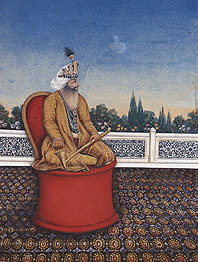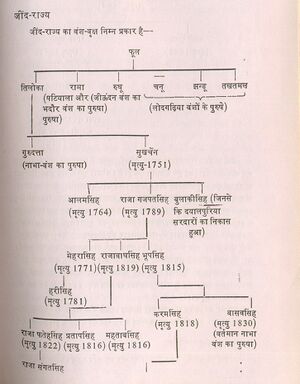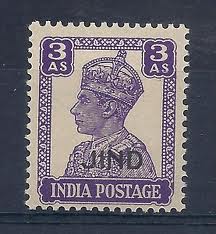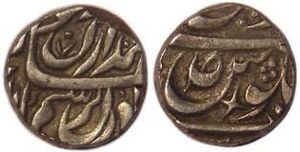Raja Gajpat Singh

Raja Gajpat Singh (b.1738-d.1789) was Sidhu - Jat ruler of Jind in Haryana.
The origin of the family of Jhind

Lepel H. Griffin writes: [1] Until the time of Chaudhri Phul (Sidhu - Jat clan), the history of the Pattiala and the Jhind families are the same, and there is no occasion to repeat here what has already been recorded regarding it.* (See:The Rajas of the Punjab by Lepel H. Griffin/The History of the Patiala State)
Tilokha, the eldest son of Phul, had two sons, Gurditta and Sukhchen.
From the elder Gurditta has descended the Nabha family, and from the younger Sukhchen the Chiefs of Jhind, Badrukhan and Bazidpur.
Tilokha succeeded his father as Chaudhri, but although he thus became the head of the family, he was not a man of any energy, and made no attempt to increase his share of the estate.
Sukhchen, the second son, was a simple zamindar, and nothing worthy of record is known of him, except his marriage to Agan, the daughter of Chuhr Singh, a Bhullar Jat of Mandi, who bore him three sons,
He founded several new villages, one of which, called after his own name, he gave to his youngest son Bulaki Singh ; and a second, Balanwali, to Alam Singh. After having made his division of his estate, he continued to reside with his second son Gajpat Singh, at the ancestral village of Phul, where he died, aged seventy-five, in the year 1758.
* Ante, pp. 2-9
The following is the genealogy of the Jhind family (as pictured).
It is with Gajpat Singh that Jhind history is specially concerned, and the briefest notice is required of the other sons of Sukhchen.
Alam Singh, the eldest son of Sukhchen
Alam Singh, the eldest, was a brave soldier, and distinguished himself in many fights With the Imperial troops.
After the conquest of Sirhind, in 1763, he took possession of a considerable tract of country, but was killed the following year by a fall from his
horse. He left no children, though he had married three times. His first wife was of a Gill family of Cholia Chubara, his second the daughter of Man zamindar of Maur Saboki, and the last a girl, Mala by name, whom he had induced to elope from the house of her Either a Dhaliwal zamindar.
Bulaki Singh:
Bulaki Singh, the youngest son of Sukhchen, was the ancestor of the Dialpuria Sirdars, of whom a notice has been already given in the chapter on the Minor Phulkian Houses. He died in 1785.
Gajpat Singh
Lepel H. Griffin writes: [2] Gajpat Singh, the " second son, was born about the year 1783 and grow up a fine handsome youth, well skilled in all military exercises. He lived with his father at Phul, till the latter's death, assisting him against his rival and brother Gurditta, in whose time commenced the feud between the Jhind and Nabha houses, which is even now hardly healed. The great subject of dispute was the possession of Rampura Phul, the ancestral village, which each branch of the family naturally desired to own, and to which Chaudhri Gurditta's claims, as head of the Phulkian house, were perhaps the stronger. It was at the instigation of Gurditta, that, in 1743, when Gajpat Singh was five years old, both he and his mother Agan were captured by the Imperial troops and carried prisoners to Dehli as hostages for Sukhchen, who had fallen into arrears with his revenue collections, and who contrived to escape the troops sent to seize him. The mother and child were fortunate enough to soon escape through the fidelity and courage of one
* Vide ante p. 307.
of Agan's slave girls, who disguised her mistress in her own dress and remained behind in her place in the prison.
Relation with Maharaja Ranjit Singh of Lahore
Maharaja Ranjit Singh of Panjab was the son of a Mallava Lady, named Raj Kaur, daughter of Raja Gajpat Singh of Jind. In the house of her husband, Sardar Maha Singh, she was known as Mai Malvain, the lady of Maalva (called as such after its occupation by the Mallavas). Maharaja Ranjeet Singh was born in the small fortress town of Badrukhan near Jind, the home town of Raj Kaur's mother, with whom, according to custom, Raj Kaur had to stay for the delivery of her first child (Singh, Khushwant; Ranjit Singh, 1962, London, pp. 21ff). [3]
The family of Gajpat Singh
Gajpat Singh married, in 1754, one of the widows of his brother Alam Singh, and succeeded to his estate of Balanwali. This wife bore him one daughter, Begama. Previous to this he had married the daughter of Kishan Singh of Monshia, of whom were born four children, Mehr Singh, Bhag Singh, Bhup Singh, and a daughter Raj Kour, who was married to Sirdar Mahan Singh Sukarchakia and became the mother of Maharaja Ranjit Singh of Lahore.
His conquests and misfortunes:
Gajpat Singh joined the Sikh army in 1768, when Zin Khan the Afghan Governor of Sirhind was defeated and slain ; and he then seized a large tract of country, including the districts of Jhind and Safidon, overrunning Panipat and Karnal, but he was not sufficiently strong to hold them. Yet, in spite of this rebellion, he did not deny altogether the authority of the Dehli Court. He remained, as before, a Malguzdr of Dehli, paying revenue to the Emperors; and, in 1767, having fallen a lakh and a half into arrears, he was taken prisoner by Najib Khan, the Muhammadan Governor, and carried to Dehli, where he remained a prisoner for three years, only obtaining release by leaving his son, Mehr Singh, as a hostage for the punctual payment of what was due. He then returned to Jhind, where, after great difficulties and delay, collecting three lakhs of Rupees he carried them to Dehli and not only freed his son, but obtained the title
He obtains the title of Raja AD 1768:
of Raja, under a Royal Firman or grant.* From this time Gajpat Singh assumed the style of an independent prince, and coined money in his own capital.†
The marriage of Raj Kor to Sirdar Mahan Singh:
In 1774, the marriage of Sirdar Mahan Singh Sukarchakia was celebrated with Raj Kour, the daughter of Raja Gajpat Singh, at Bhadra Khan, then the capital of Jhind. The Gujranwala Chief came with a large retinue, and all the Phulkian Chiefs were assembled in honor of the occasion. A trifling incident which occurred during the festivities was the cause of a serious quarrel between Nabha and Jhind. The Sirdar of the former State, Hamir Singh, had a valuable grass preserve or "Bir" in the neighbourhood of Bhadra Khan, in which the Baratis or attendants of the bridegroom, were permitted to cut grass for their horses. But no
* This Firman is dated 25th Shawal 1185 A. H. (A. D. 1772) under the Seal of the Emperor Shah Alam.
† The right of coining 18 a privilege which belongs to independent Chiefs alone, as the term “independent” is technically used in Indian politics.
sooner had they commenced operations than Yakub Khan, the Agent of Hamir Singh, more zealous than hospitable, attacked them and a fight was the result, of which no notice was taken till after ceremony and departure of the bridegroom.
The quarrel with Nabha:
Raja Gajpat Singh then resolved to avenge the insult, and feigning to be at the point of death, sent to his cousin of Nabha requesting him to come and see him before he died. The unsuspecting Sirdar arrived in haste, with Yakub Khan, and to his great surprise was arrested and placed in confinement, while his officer was put to death. The Raja then sent a force against Imloh and Bhidson, two strong places in Nabha territory,
and attacked Sangrur, which was defended for four months by Sirdarni Deso, wife of Hamir Singh. At length, seeing her cause desperate, she begged the Raja of Pattiala to interfere. This Chief, who had encourage, the attack in the first place, hoping to weaken both Jhind and Nabha and consequently increase his own power, had no wish to see the former become too powerful, and interposed with other Sikh Sirdars, compelling Raja Gajpat Singh to restore Imloh and Bhadson and release Hamir Singh. Sangrur was retained and has ever since been included in the Jhind territory.
Jhind attacked by the Governor of Dehli:
The next year Rahim Dad Khan, Governor of by Hansi, was sent against Jhind by the Dehli Governor Nawab Majad-ul-dowla Abdulahd Khan, and Raja Bhag Singh summoned to his assistance the Phulkian Chiefs.
Raja Amar Singh of Pattiala, who sent a force under Diwan Nanun Mal, Sirdar Hamir Singh of Nabha with the Bhais of Kythal assembled for its defence, and compelled the Khan to raise the siege and give them battle, in which he was defeated and killed. Trophies of this victory are still preserved at Jhind, and the tomb of the Khan is to be seen within the principal gate.
The conquest to the south:
After this, Gajpat Singh, accompanied by the Pattiala detachment, made an expedition against Lalpur in Rohtak, and obtained, as his share of the conquered country, the district of Kohana. But Zalita Khan, the son of the Rohilla Chief Najib-ud-dowlah, (Najib Khan), marched with Ghulam Kadir against the allied Chiefs with so strong a force that they saw it was hopeless to resist, and, at an interview at Jhind, the Raja was compelled to
I. Political conditions etc.- The Jhind Mint would seem to have been established at the same time as that of Pattiala, as the inscription is exactly the same. There does not appear to have been any correspondence with this Agency or the British Government regarding its continuance or conditions.
II. Nature, title, and character of the coinage, The rupee is called the " Jhindia ; " it is 11-1/4 mashas in weight.
The inscription is, as in the case of the Patiala Rajah Shai rupee,
- "Hukm shud az Qadir-i-bechun ba Ahmad Badshah
- Sikha zan bar sim-o-zar az ouj-i-mahi ta ba Mah"
The the third sentence which appears on the Pattiala coin is omitted in the Jhind inscription.
Translation of the inscription has been given above.
III. The out-turn is quite uncertain; on the occasion of marriages large sums are coined, but otherwise only the actual quantity considered
give up A portion of Kohana, though he was allowed to retain certain villages known as Panjgiran, and Pattiala had also to abandon a great part of its conquests in Hisar, Rohtak and Karnal.*
The relation of Raja with Pattiala:
Raja Gajpat Singh Was a constant ally of the the Pattiala Chief and accompanied him on many of his expeditions. He Joined in the attack on Sirdar Hari Singh of Sialba ; aided in subduing Prince Himmat Singh, who had risen in revolt against his brother Raja Amar Singh; and, in 1780, marched with a force composed of Pattiala and Jhind troops to Meerat, were the Sikhs were defeated by Mirza Shafi Beg, Gajpat Singh being taken prisoner, and only released on payment of a heavy ransom.
necessary is struck. The value of the coin is said to be about 12 annas, but I have been unable to procure a specimen in Ambala, and the shrafs in our markets know little about this coin.
IV. Process of manufacture, etc— The only point noted is, that the die is entrusted to the care of the State Treasurer, the process of manufacture and arrangements of the workshops, &c, is not noticed.
V. The arrangements for the receipt of bullion, — Bullion has never been tendered for coining at the Jhind Mint, so no rates for conversion have been fixed.
VI. The general area of currency- Only Within the State of Nabha.
- * Vide ante p. 44.
When Raja Sahib Singh succeeded his father at Pattiala, Raja Gajpat Singh did his best to restore order, and assisted Diwan Nanun Mal to put down the rebellion of Sirdar Mahan Singh who had proclaimed himself independent at Bhawanigarh. He also in person marched against Ala Singh of Talwandi, who had thrown off the authority of Pattiala.
Death of Raja Gajpat Singh
Death of Raja Gajpat Singh and his eldest son, Mehar Singh, with the extinction of this branch of family:
In 1786, while engaged in an expedition against refractory villages in the neighbourhood of Ambala, with Diwan Nanun Mal and Bibi Rajindar, sister of the Raja of Pattiala, he fell ill with fever and was carried to Sufidon, where he died, aged fifty-one. His eldest son, Mehr Singh, died in A. D. 1780, leaving, one son, Hari Singh, who was put in possession of Safidon by Raja Gajpat Singh.
But he was of dissipated habits, and in a state of intoxication fell from the roof of his house and was killed. This was in 1791, when he was only eighteen years of age. He left a daughter, Chand Kour, who was married to Fatah Singh, the son of Sirdar Bhanga Singh, the powerful Chief of Thanesar. After her husband's death, she, with his mother Mai Jiah, and another widow, Rattan Kour, succeeded to the estate which fell entirely into her possession in 1844, and was held by her in independent right till her death in 1850, when it lapsed to the British Government. The widow of Hari Singh, Dya Kour, retained, till her death, the district of Khanna, which had been given to her by her father-in-law, when it also lapsed.
The fort of Jhind built
The town of Jhind was much enlarged by Raja Gajpat Singh, who built a large brick fort on its northern side, but at no time was it a place of much strength.
राजा गजपतसिंह


राजा गजपतसिंह (b.1738-d.1789) पटियाला-स्टेट एवं जींद-स्टेट दोनों राजवंश के पुरखा चौधरी फूल की चौथी पीढ़ी में सिद्धू गोत्र का जाट था। जाट इतिहास:ठाकुर देशराज (पृ.476-77) से इनका इतिहास नीचे दिया जा रहा है।
चौधरी फूल के बड़े लड़के तिलोका के दो पुत्र हुए- गुरुदत्तसिंह और सुखचैन। बड़े भाई गुरुदत्तसिंह के वंशज नाभा-स्टेट और छोटे भाई सुखचैन के रियासत जींद, सरदार बड़रूखां व बाजेदपुर थे।
अपने पिता के पश्चात् तिलोका को चौधरायत मिली, परन्तु वह इतना होशियार न था कि रियासत की उन्नति करता।
तिलोका का दूसरा बेटा सुखचैन जिसके वंशज जींद स्टेट के राजगान थे, एक जमींदार की हैसियत से था। इसकी शादी मंडी गांव के एक जाट के यहां हुई थी। इसने अपने नाम पर एक गांव भी बसाया था, जो अपने छोटे बेटे बुलाकीसिंह को दिया था। इस तरह के बटवारे के पश्चात् वह अपने बेटे गजपतसिंह के साथ गांव फूल में रहा करता था और सन् 1751 में 75 वर्ष की उम्र में देहान्त हो गया।
सुखचैन का विशेष इतिहास नहीं मिलता। इसके तीन लड़के थे - आलमसिंह, गजपतसिंह और बुलाकीसिंह। आलमसिंह से इस स्टेट का इतिहास पूरा मिलता है।
राजा गजपतसिंह का जन्म सन् 1738 के करीब हुआ था। यह अत्यन्त खूबसूरत और सुडौल जवान था, अपने पिता के साथ गांव फूल में रहता था। इसने अपने पिता के साथ गुरुदत्तसिंह (गजपतसिंह के चचा च नाभा के पुरखा) से मुकाबला करने में पूरी सहायता की। यह वह समय था जबकि नाभा और जींद दोनों के आपसी झगड़े की नींव पड़ी और जिसके कारण दोनों स्टेटों को ही समय-समय पर काफी नुकसान उठाना पड़ा। इस झगड़े से उत्पन्न फूट पापिनी का ही परिणाम था कि सन् 1743 में जबकि गजपतसिंह की उम्र सिर्फ 5 साल की थी, अपनी माता के साथ शाही फौज द्वारा गिरफ्तार होकर देहली जाना पड़ा था। देहली से फौज तो सुखचैन को गिरफ्तार करने आई थी, परन्तु वह हाथ न आए। दैवयोग से इनको अधिक समय तक कैद में न रहना पड़ा।


सन् 1754 में गजपतसिंह ने आलमसिंह की विधवा से नाता किया और रियासत बालानवाली का मालिक हुआ। इससे एक लड़की पैदा हुई। इसके अलावा उसने किशनसिंह मानसिंह की लड़की से शादी की थी, जिससे चार सन्तान पैदा हुई थीं - मेहरसिंह, बाघसिंह और भूपसिंह तीन पुत्र तथा एक पुत्री राजकुंवरि जिसकी शादी सरदार महासिंह सुकरचकिया से हुई थी और जिसकी कोख से पंजाब शेर रणजीतसिंह उत्पन्न हुए।
सन् 1763 तक गजपतसिंह ने अपने राज्य की हद बहुत बढ़ा ली थी, यहां तक कि पानीपत व करनाल तक उसका हाथ पहुंच गया था। वह बड़ा राजनीतिज्ञ भी था, वह जानता था कि इतने इलाके की वह शीघ्र ही अपने प्रति प्रीति उत्पन्न न कर सकेगा, इसलिए उसने बराबर बादशाह देहली से सम्बन्ध रखा और खिराज भेजता रहा। सन् 1767 के करीब उस पर मालगुजारी का डेढ़ लाख रुपया हो गया था, इसलिए वह देहली गिरफ्तार कर लिया गया। वहां पर वह करीब 3 वर्ष तक रहा, परन्तु फिर अपने लड़के मेहरसिंह को, जब तक रुपया न दे, देहली छोड़ जींद लौट आया और वहां से 3 लाख रुपया जमा करके देहली गया। इस पर उसके और मेहरसिंह के जींद आने की सहूलियत ही नहीं हुई बल्कि उसे राजा का खिताब भी मिला एवं अब से वह खुद-मुख्तार रईस माना जाने लगा और उसने अपना सिक्का भी जारी किया। सन् 1744 में राजकुंवरि की शादी सरदार
जाट इतिहास:ठाकुर देशराज, पृष्ठान्त-477
महासिंह सुकरचकिया से हुई। इस समय में बड़रूखां रियासत जींद की राजधानी थी। वहीं पर तमाम फूल के रईस तथा और भी कई सरदार इकट्ठे हुए और शादी का समारोह बड़ी धूमधाम से समाप्त हुआ। परन्तु इस शादी में एक बड़ा भारी तनाजा भी पैदा हुआ। नाभा की हद का एक बीहड़ बड़रूखां के पास ही था, जिसमें बरातियों को अपने घोड़ों के वास्ते घास काट लेने की आज्ञा दी गई थी। लेकिन जब उन्होंने घास काटनी शुरू की तो हमीरसिंह (जो उस समय नाभा का शासक था) के हाकिम याकूबखां ने मेहमानों का कुछ भी ख्याल न करके उन पर हमला कर दिया। थोड़ी सी छेड़-छाड़ के बाद उस वक्त तो यह मामला शान्त हो गया, पर गजपतसिंह इसे भूल न सका और इसे उसने अपनी तौहीन समझी। इसका बदला लेने के लिए उसने एक निन्दनीय नीति ग्रहण की अर्थात् उसने अपना स्वास्थ्य संदेहात्मक बतलाकर मृत्यु से पहले हमीरसिंह से मिल जाने के लिए आने को कहला भेजा। हमीरसिंह को क्या पता था कि तेरे साथ यह चाल चली जा रही है! उसने याकूबखां के साथ बिना किसी अभियान के सादे ढ़ंग से ही मिलने के लिए प्रस्थान कर दिया। वहां पहुंचते ही याकूब को मार दिया गया और हमीरसिंह को कैद कर लिया। अमलोह व भादसों पर जो नाभा के इलाके में हैं, चढ़ाई की, और संगरूर पर हमला किया। हमीरसिंह की रानी ने चार महीने तक अच्छी तरह सामना किया और जब स्वयं बचाव न कर सकी तो राजा साहब पटियाला से सहायता के लिए प्रार्थना की। राजा साहब से जितनी आशा थी, रानी साहिबा को हासिल न हुई अतः संगरूर जींद के कब्जे में हो ही गया। परन्तु अमलोह और भादसों वापस करने, राजा हमीरसिंह को रिहा कर देने पर गजपतसिंह को महाराजा पटियाला और कुछ सिख सरदारों ने मजबूर कर दिया।


दूसरे वर्ष ही रहीमदादखां हाकिम हांसी को सूबेदार देहली ने जींद के मुकाबले के लिए भेजा। राजा गजपतसिंह ने फुलकियां सरदारों से सहायता मांगी। राजा अमरसिंह पटियाला ने एक सेना दीवान नानूमल के सेनापतित्व में भेजी। नाभा से हमीरसिंह स्वयं कैथल के भाई-बन्दों के साथ जींद की सहायता के लिए चढ़ आया। इन सबने रहीमदादखां को मैदान में लड़ाई लड़ने के लिए आने को बाध्य किया। रहीमदादखां ने बुरी तरह से हार खाई और खुद मारा गया। इस विजय के चिह्न अब तक जींद में मौजूद हैं और रहीमदादखां की कब्र दरवाजा खास के भीतर दृष्टिगोचर होती है। इसके बाद गजपतसिंह ने पटियाला की फौज के साथ ही लालपुर जिला रोहतक पर हमला किया। इस हमले में जिला गोहाना इनके कब्जे में आया। पर जब जाब्ताखां ने जमैयत इकट्ठा कर लड़ाई के लिए कूच किया तो इन्होंने मुकाबला करना ठीक न समझा और जींद में एक मुलाकात के समय एक हिस्सा गोहाना का राजा साहब को छोड़ना पड़ा। पटियाला को भी हिसार, रोहतक और करनाल में से एक बड़ा हिस्सा छोड़ देना पड़ा।
जाट इतिहास:ठाकुर देशराज, पृष्ठान्त-478
राजा गजपतसिंह और पटियाला के राजा अमरसिंह में मित्रता का व्यवहार था। जब अमरसिंह से हिम्मतसिंह ने बगावत की थी तो राजा साहब ने सहायता की थी और सन् 1780 में पटियाला और जींद की फौजों के साथ मेरठ की तरफ कूच किया, जहां पर सिखों को मिर्जा शफीबेग के साथ लड़ने पर विजय-श्री ने साथ न दिया था और गजपतसिंह भी कैद हो गया पर बाद में समझौते पर रिहा हुए। साहबसिंह के पटियाला में उसके नाम के बाद अधिकारी होने में गजपतसिंह ने बड़ी कोशिश की और सरदार महासिंह की बगावत दूर करने में अत्यन्त तत्परता से सहायता की। राजा साहब समय-समय पर पटियाला को सहायता देने से विमुख न हुए। इससे जाना जा सकता है कि पटियाले के साथ राजा साहब का दोस्ताना सम्बन्ध था।
राजा गजपतसिंह का बड़ा पुत्र सन् 1780 में मर गया।1 इसके एक बेटा हरीसिंह था जिसको गजपतसिंह ने सफेदों का इलाका दे दिया था। हरीसिंह बड़ा नशेबाज था और एक दिन नशे की हालत में ही अपने मकान की छत पर से गिर पड़ा और मर गया। यह बात सन् 1791 की है। इस वक्त इसकी उम्र 18 वर्ष की थी। हरीसिंह के एक लड़की थी जिसका नाम चन्द्रकुंवरि था। इसकी शादी फतेहसिंह के साथ जो भंगी मिसल का सरदार था, हुई थी। पति के मर जाने के बाद चन्द्रकुंवरि और उसके साथ एक दूसरी विधवा रानी रियासत की मालिक हुई। सन् 1744 में रियासत बिल्कुल उसके अधिकार में आ गई और मरने तक उसका अधिकार रहा। सन् 1850 में उसकी मृत्यु हो गई और रियासत बतौर लावारिस होने के अंग्रेजी गवर्नमेंट ने ब्रिटिश भारत में शामिल कर ली। हरीसिंह की विधवा का इलाका भी उसकी मृत्यु के पश्चात् गवर्नमेंट अंग्रेजी के अधिकार में हो गया।
सन् 1789 में राजा गजपतसिंह का भी स्वर्गवास हो गया। राजा साहब बड़े साहसी और बुद्धिमानी शासक थे। इन्होंने रियासत का इन्तजाम भी समयानुसार उचित रीति से किया था और राज्य-विस्तार करने में भी समयानुकूल कार्य करते ही रहे। शहर जींद की शोभा बढ़ाने की ओर भी आपका ध्यान था, इसीलिए आपने एक पक्का किला भी तैयार कराया था।
External links
References
Back to The Rulersf

